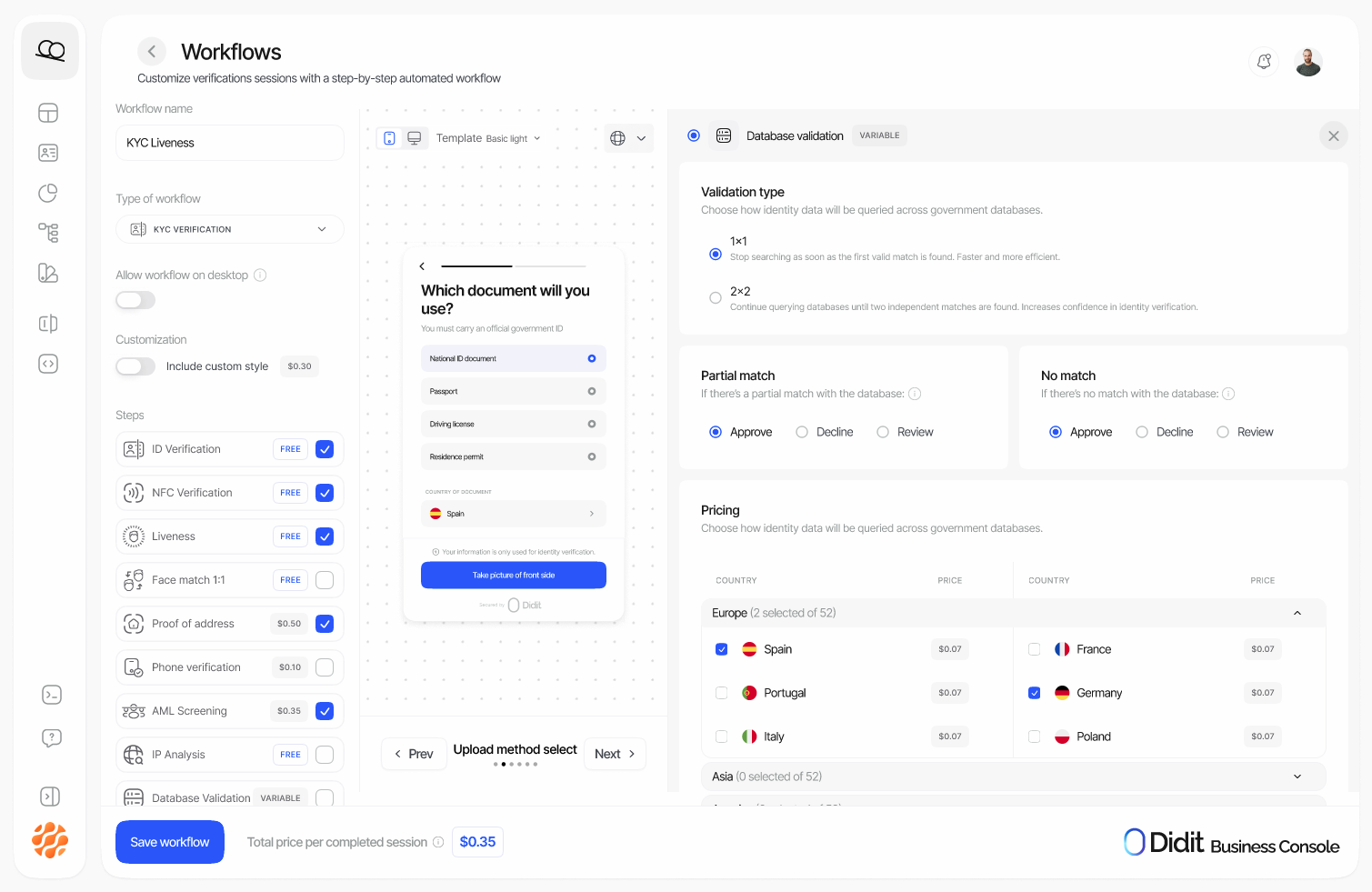Database Validation is a crucial security feature that verifies customer's personal data and identity documents against trusted, authoritative sources. This process helps safeguard your business from risks like synthetic identity fraud and ensures that users are of legal age, enhancing your compliance with AML/CTF requirements.
By matching user and document details against official government and financial databases, this feature adds a powerful layer of security to your onboarding process. It ensures the data provided by users is genuine and accurate, increasing identity verification assurance and boosting conversion rates by building trust.

How Database Validation Works
Our Database Validation system is designed to be both flexible and robust. The process is initiated automatically as a step within the KYC workflow if the database validation feature is activated.
Here's a simplified breakdown of the flow:
- Data Extraction: When a user submits an ID document, our system retrieves key information, such as full name, date of birth, and national identification numbers (e.g., CPF in Brazil).
- Configuration Check: The system checks if Database Validation is enabled for the document's issuing country in your application settings.
- Data Sufficiency Check: It verifies if all the necessary data points required by the specific country's validation source have been successfully extracted.
- API Call: If the country is enabled and all required data is present, our system makes a request to the relevant authoritative data source (e.g., a national registry).
- Result Analysis: The response from the external database is analyzed, and a match level is determined (
FULL_MATCH,PARTIAL_MATCH, orNO_MATCH). - Action Trigger: Based on the match result and your configured settings, the session is either automatically
Approved,Declined, or moved toIn Reviewfor manual inspection.
This entire process is logged, and a detailed record of the validation, including the costs, is stored for auditing purposes.
The Validation Process
Database Validation is seamlessly integrated into the ID verification flow. It is triggered automatically and incurs a charge only under specific conditions:
- The ID verification feature must be part of the active KYC workflow.
- The document provided by the user must be from a country for which you have enabled Database Validation.
- The system must successfully extract all necessary information from the document to perform the check.
We also have the Database Validation API where you can directly request the database validation adding some input data.
Handling Insufficient Data
In rare cases, such as when a document image is very blurry, our OCR might fail to extract all the required data points. When this happens:
- The Database Validation check is temporarily paused, and a log is created indicating the missing information.
- The session status is typically set to
In Review. - You can then manually enter the missing data in the session details view in your console.
As soon as you save the updated information, the Database Validation process is automatically re-triggered to complete the verification.
Configuration
You have full control over the Database Validation feature through your console. You can enable or disable it, and specify which validation method to use for each supported country.
For example, you can enable a 1x1 Matching for different countries:

Workflows: Database Validation Settings
The action taken for PARTIAL_MATCH or NO_MATCH results can also be configured. You can choose to automatically Decline the session, or send it for manual Review.
Matching Methods
We support several methods for validating data, each with different capabilities and data sources. The availability of these methods varies by country.
- 1x1: This method involves matching one input data point (typically a national ID or similar identifier) against our database. If a direct match is found, we confirm the identity. However, if the initial attempt fails, we may try alternate trusted data sources in a waterfall sequence. This means we continue validating through successive providers until we either achieve a match or exhaust all options. Importantly, a partial match does not stop the process—we only stop once we find a full and conclusive match or determine that no match exists.
- 2x2: This method requires matching two input data points (e.g., name + date of birth, or national ID + phone number) against two corresponding fields in our database. Just like with 1x1, we follow a waterfall approach, querying multiple data sources sequentially. We persist through each step until we find a complete match across both data fields. Partial or single-field matches are not sufficient; the validation process continues until a definitive 2-field match is achieved or all sources have been checked.
For a detailed explanation of each method and the decision logic behind them, please see our guide:
➡️ Database Validation Matching Methods
Pricing
The cost of Database Validation varies depending on the country and the validation method used. Each check is billed as a separate event.
For a complete and up-to-date list of prices, please visit the Pricing page.
